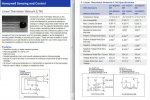I want to use a 10k thermistor as the sensor for a precision PICAXE thermometer and thermostat. The range of temperatures that I need to read is from 95.0 degrees F to 106.0 degrees F. I would like for the resolution of the thermometer to be .1 degrees with no interpolation required. The way that I think this might be accomplished is by storing a data point for each of the 111 .1 degree readings in the range to be covered; these data points would be derived from the corresponding resistances of the 10k thermistor that I plan to use. (I have those resistance values for the 111 temperature data points; each of the values is a four digit decimal value.)
Unfortunately, I don't really know if this is possible and I certainly don't know how to do it. I think I would put these resistance values in a data table along with the corresponding temperature to be displayed, but it may be that I need to use the resistance values in conjunction with a voltage divider circuit and store the corresponding voltage values. I also don't know if the PICAXE-18X has sufficient memory space for this data.
I have spent most of the day today thinking about this, looking at potentially applicable code, and reading the manual; I intend to continue to try to work this out on my own, but if you have some helpful information or insight, I would be glad to get it. My coding skills are very limited.
Thanks in advance for your constructive input.
Unfortunately, I don't really know if this is possible and I certainly don't know how to do it. I think I would put these resistance values in a data table along with the corresponding temperature to be displayed, but it may be that I need to use the resistance values in conjunction with a voltage divider circuit and store the corresponding voltage values. I also don't know if the PICAXE-18X has sufficient memory space for this data.
I have spent most of the day today thinking about this, looking at potentially applicable code, and reading the manual; I intend to continue to try to work this out on my own, but if you have some helpful information or insight, I would be glad to get it. My coding skills are very limited.
Thanks in advance for your constructive input.
Last edited:

